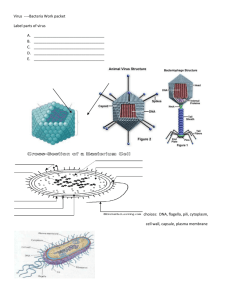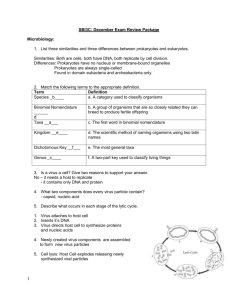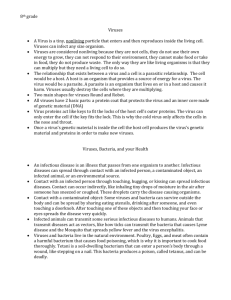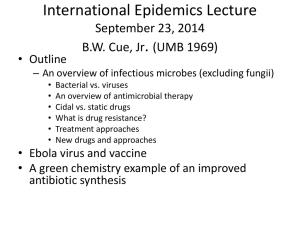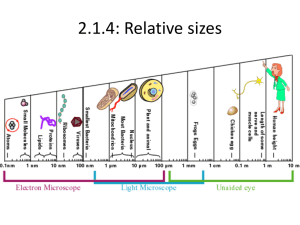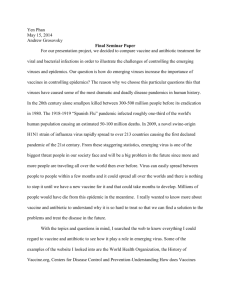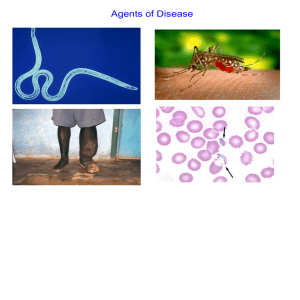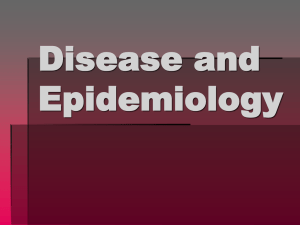bacteria PPT test
advertisement
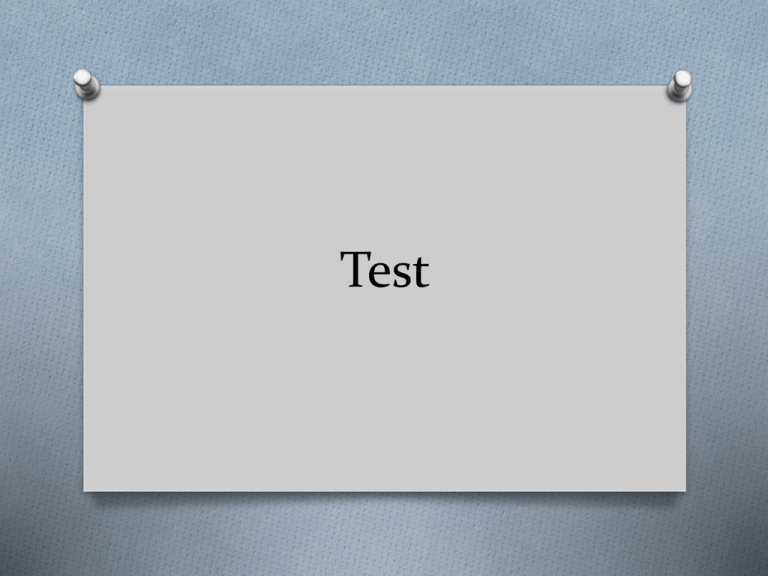
Test Rules O Each group will answer the question at the same time by holding up the correct answer after a count down O Each correct answer is worth 1 point O There are 29 questions, this is worth 29 points The genetic material of a virus is found in its a. b. c. d. coat. core. coat and core. nucleus. A virus’s proteins are important because they a. b. c. d. contain genetic material. make new virus particles. provide energy for the virus. help the virus attach to its host. Which of the following statements does NOT describe an active virus? a. b. c. d. It attaches to the host cell. It takes over the host cell’s functions. It “hides” in the host cell. It destroys the host cell. What characteristic of viruses makes them useful in gene therapy? a. b. c. d. their ability to enter cells their ability to remain inactive for a long time their inability to multiply in cells their inability to take over the functions of host cells O Which shape describes some bacterial O O O O cells? a. cube-shaped b. bullet-shaped c. spiral d. robotlike Which of the following is found in the cytoplasm of bacterial cells? a. b. c. d. cell membrane nucleus genetic material flagella What process results in genetically different bacteria? a. b. c. d. binary fission respiration conjugation asexual reproduction Endospores form during a. b. c. d. binary fission. sunlight hours. respiration. harsh environmental conditions. What important role do bacteria called decomposers play? a. b. c. d. They return basic chemicals to the environment. They slow down food spoilage. They kill harmful bacteria. They produce vitamins. Which of the following is NOT a role of bacteria that live in human bodies? a. b. c. d. digesting food competing for space with diseasecausing bacteria making vitamins fixing nitrogen Which of the following is an example of indirect contact that spreads some infectious diseases? a. b. c. d. touching an infected person animal bites hugging an infected person inhaling infected drops of moisture Which infectious disease is NOT transmitted by an animal bite? a. b. c. d. encephalitis rabies botulism Lyme disease The best treatment for most viral infections is a. b. c. d. an over-the-counter medication. a vaccine. an antibiotic. bed rest. How does a vaccine work? a. b. c. d. It activates the body’s natural defenses. It weakens the cell walls of bacteria, causing the cells to burst. It treats the symptoms of an infection. It attacks antibiotic-resistant bacteria. Binary fission is the bacterial process of a. b. c. d. asexual reproduction. obtaining food. producing energy. forming endospores. Viruses are considered to be nonliving because they a. b. c. d. cannot multiply. use energy to grow. are smaller than bacteria. do not show all the characteristics of life. The process of breaking down food to release its energy is called a. b. c. d. conjugation. respiration. binary fission. nutrition. Heterotrophic bacteria obtain food by a. b. c. d. capturing the sun’s energy. using the energy from chemicals in their environment. consuming autotrophs and other heterotrophs. helping autotrophs make food. Which virus is named for the organism that it infects? a. b. c. d. Ebola virus smallpox virus bacteriophage Epstein-Barr virus What directly provides energy for a virus? a. b. c. d. food its host the sun a parasite Which phrase describes the size of virus particles? a. b. c. d. smaller than cells slightly larger than cells the same size as cells much larger than cells Which statement about a virus’s coat is NOT true? a. b. c. d. It protects the virus. It contains protein. It contains genetic material. It helps the virus attach to its host. A hidden virus a. b. c. d. cannot attach to a host cell. becomes part of the host cell’s genetic material. immediately takes over the cell’s functions. attaches to but does not enter the cell. Which of the following structures are always found in bacterial cells? a. b. c. d. nuclei ribosomes flagella coats The term “antibiotic resistant” refers to bacteria that a. b. c. d. are resistant to a vaccine. survive in the presence of an antibiotic are weakened and destroyed by antibiotics. are dead or altered. Which disease can be contracted by inhaling infected droplets? a. b. c. d. tetanus rabies flu Lyme disease Many bacterial diseases can be cured using a. b. c. d. toxins. endospores. viruses. antibiotics. You have a cold, but your doctor will not give you an antibiotic, because a. b. c. d. antibiotics do not kill viruses. colds are not infectious. antibiotics make colds worse. antibiotics provide bacteria with food. Which of the following stimulates a person’s body to produce chemicals that destroy viruses or bacteria? a. b. c. d. antibiotic vaccine toxin endospore

